
A lot of sales teams get sales tracking all wrong: It's not about gathering as many metrics as you can and throwing them into some spreadsheet or dashboard.
Just like tracking calories isn’t the solution to losing weight, just tracking sales metrics isn’t the solution to improving your process.
It’s what you do with the data that counts.
That’s why true sales tracking should involve taking all the relevant data and turning it into something you can use to adjust your process and increase sales.
If you want to become an expert at sales tracking, you’ve come to the right place. By the end of this guide, you’ll know exactly how to track your sales successfully, and how to use that data to empower your team.
Looking to optimize total contract value? Psst, our article can show you how.
What is Sales Tracking?
Your sales process is like a puzzle. Not some kiddy 100-piece puzzle, but that monstrous 5,000-piece puzzle your grandmother always had half-finished on the dining room table.
So many intricate metrics make up that process, including your customer behavior, buyer journey, lead generation, selling activities, emails, calls, social signals, and so much more.
Sales tracking is like analyzing each piece of that enormous puzzle and understanding exactly how it fits into the bigger picture.
So, why is sales tracking so important for your business? Here are six ways sales tracking can benefit both your sales team and your business:
- Gives you insight based on real data: No more guesswork! Plus, if you track the data in real time, you’ll be able to make quick decisions based on what’s happening with your sales right now, not what happened last week.
- Helps you build a clear path to your goals: When you understand exactly how different actions affect your bottom line, you’ll know what to change and how to structure your process so your sales team consistently reaches its goals.
- Allows you to track symptoms before problems become critical: Ever felt like a certain action or step in your process just isn’t bringing the results it used to? Tracking sales metrics gives you a clear view of what’s stopped working, and you’ll have time to change your process before the problem becomes critical.
- Shows sales managers what their reps are doing: Different types of sales activity tracking help sales managers see which team members are winning more deals, and which ones are struggling. It also shows the strengths and weaknesses of each individual rep, which allows managers to coach their reps more effectively.
- Allows you to quickly test new ideas and methods: For example, if you add a new lead capture to your website, sales tracking will tell you almost immediately whether that’s working or not by the number of new leads coming in. This allows you to test new sales methods quickly and stick with the ones that work.
- Helps you give more personalized offerings to your customers: When you track customer behavior and other related metrics, you’ll know exactly what to offer certain customers. You can also identify behavior-based triggers and time your outreach and follow-ups better than ever.
6 Types of Sales Tracking (and Which Metrics Matter)
To start tracking your sales, you need to decide what type of tracking your team needs. Here are six different types of tracking that you’ll want to consider, plus the main metrics you’ll need for each one:
1. Sales performance tracking
This is ideal for sales managers looking to track the performance of the reps on their team.
Take a look at metrics such as:
- Cold calls made
- Emails sent
- Call duration
- Emails opened
- Email responses
- SMS sent
- Total lost opportunities
- Meetings completed
- Meetings declined, canceled, or no-shows
- Total value created
- Opportunities won
- Total time spent on selling activities
Looking at these metrics and separating them by rep tells sales managers who is succeeding, who is struggling, and which areas those reps are struggling most in.
In Close, sales managers can easily see these metrics displayed per rep in the Activity Comparison report. You can also customize how you view this chart to see only the metrics that matter most to you:
 |
This gives you a clear picture of your team’s performance.
2. Sales lead tracking
Effective lead tracking involves taking metrics about their behavior, comparing it to previous lead behaviors, and calculating which actions will impact their purchase decision most.
This involves tracking metrics such as:
- Last contact date
- Next action or task
- Deal size
- Project closing date
- Lead behavior (visits to your website, actions on social media, etc.)
- Lead score
- Lead status
When you track these metrics, you’ll be able to identify the most valuable leads in your list and refocus your efforts to nurture those leads effectively and close more deals.
Here’s how sales lead tracking looks in Close:
3. Sales goal tracking
Reaching your goals doesn’t happen by chance. If you’re not tracking your progress, it will be much harder to see whether or not you’ll make it until the very last moment.
If you feel like you’re always pushing desperately to make sales at the end of every quarter, sales goal tracking will help you take a more balanced approach.
Basically, you need these four metrics to set up goal tracking:
- Total revenue goal
- Monthly, weekly, and daily goals
- Daily sales totals
- Cumulative sales totals
The right sales goal tracker gives you a visual view of how close you are to reaching your goals and the number of leads or sales you need to achieve your goal.
 |
4. Sales pipeline tracking
Want to know exactly what’s happening with your sales, down to the minute? That’s what tracking your sales pipeline can do. Get real-time data on how each deal is progressing by tracking metrics like:
- Total open opportunities
- Opportunities lost per day/week/month
- Pipeline velocity
- Win rate
- Sales cycle length
- Monthly sales growth
These metrics will tell you how much money is going through your pipeline at any given time, as well as help you forecast future sales more accurately.
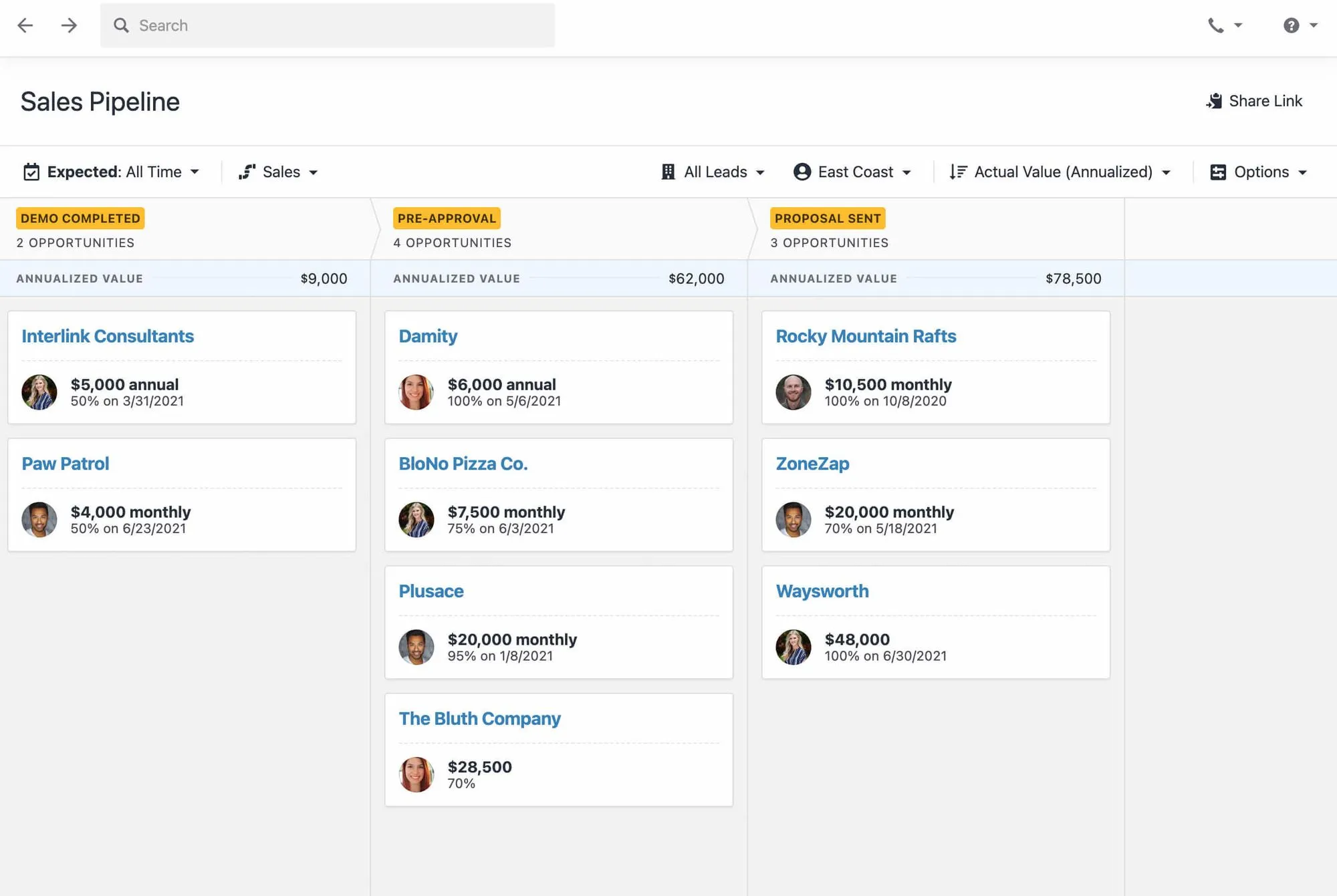 |
5. Sales activity tracking
To track your sales activities, you’ll be tracking the same metrics as you did for sales performance, like calls, emails, meetings, product demos, etc.
But this time, instead of separating by rep, you’ll look at the success rate of the activities themselves.
For example, how many of your team’s emails are getting responses? What’s the average duration of your team’s sales calls? How many new opportunities were created this month compared to last month? Does that number correlate to the number of calls made or emails sent? What’s the average response rate for SMS?
This type of tracking tells you exactly which methods are working for your team. That way, you can ensure they direct their efforts to the methods that actually bring results.
Here’s how sales activity tracking looks in Close:
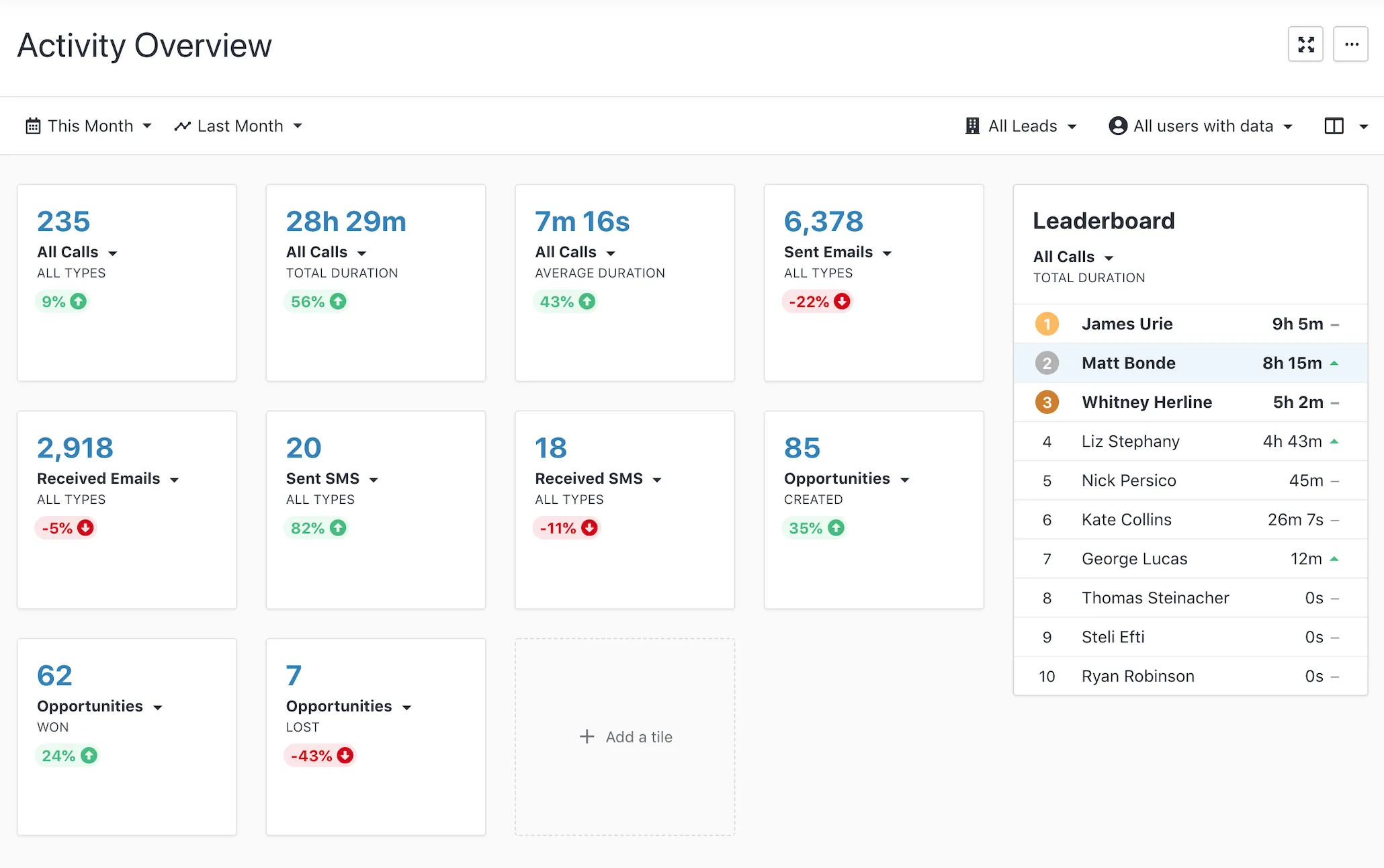 |
6. Sales funnel tracking
If you feel like a piece of your sales process isn’t working well, sales funnel tracking will tell you where it is.
Taking the different stages of your process, analyze metrics such as:
- Total inbound leads
- Total outbound leads
- Number of qualified leads per month
- Conversion rate for each stage
Tracking these metrics helps you see whether your inbound leads are really qualified for your product and how effective your outbound lead generation is. Also, tracking conversion rates will show you if there’s a certain stage where many leads or opportunities are lost. Then, you can focus on improving your efforts at that stage or changing the methods to keep pushing leads toward a sale.
Ready to get started with truly effective sales tracking?
How to Track Sales: A 5-Step Process
You’re probably already collecting data on your sales, and maybe you’ve been keeping track of some of the metrics we discussed above.
But, how can you organize those efforts into a simple sales tracking system that can be easily understood and shared?
Here are 5 steps to sales tracking success:
Step 1: Decide on the KPIs and metrics you need to track
As we just saw, the different types of sales tracking require different metrics. Besides that, your business probably has its own unique KPIs that give you a quick glimpse at the health of your pipeline.
But gathering more metrics doesn’t necessarily translate into better sales tracking. Remember, complexity isn’t difficult to achieve; it’s difficult to resist.
So right now, choose the metrics and KPIs that empower your team to do their best. Pick the ones directly connected to your specific goals, and stick with those.
Try to start with less than 10 key metrics. You can always add more metrics in the future, but for now, keep it simple.
 |
Step 2: Define your sales process and set up your pipeline
For your sales tracking to be actionable, you’ll need a process and a pipeline to apply those insights to.
If you haven’t done so already, take some time to set up your own unique sales process. Look at your current customers and analyze the journey they took from becoming a lead to making a purchase decision. Then, refine that journey into your specific steps to win that sale.
Once your process is complete, you can create your own sales pipeline. This takes the different stages of your sales process and allows you to view where your leads are at each stage.
Step 3: Gather your data into one single source of truth
While most of the data you need will come from your CRM, some of the data may come from other tools.
To set up simple sales tracking, you must gather those data points in one place. That way, you can easily analyze and interpret that data without switching back and forth between different tabs or apps.
Start by defining where the data for your key metrics is stored. Then, pick the place where you want to send that data (for example a sales dashboard tool).
If your chosen source of truth integrates with the tools where your data is stored, just set up the integrations and get going! If not, use Zapier to set up automations that bring your data to the right place without any manual data entry.
 |
Step 4: Turn your data into actionable insights
Once your insights are gathered, it’s time to turn them into something you can use.
The best way to do this is to regularly analyze the metrics you’ve saved, and use them to answer specific questions. Set aside time every month or quarter to run through your analysis and use the results to adapt your process.
For example:
- Are there specific actions your team is taking that are producing fewer results?
- Which reps are reaching their sales quota? Which ones aren’t?
- Can goal attainment be linked to a specific sales action?
- Where are leads getting lost or stuck in the pipeline?
- What actions are reps taking at these stages where leads aren’t moving forward?
- Where are leads moving faster through the pipeline? Why there?
- Are any reps struggling with certain sales activities, such as cold calls or product demos?
- How do any changes you’ve made affect the overall conversion rates?
- What specific behaviors indicate a lead is about to churn?
By looking at the data and asking yourself these questions, you can identify opportunities for improvement and take action.
For example, if you see that many leads are getting stuck at the meeting stage, you can take a deeper look at why. Are leads simply not interested in taking the meeting? If so, maybe you can help your reps sell the value of the meeting itself rather than just trying to book an appointment.
Step 5: Share these insights with other teams
Once you set up your sales tracking system, it’s time to share those insights.
Sales isn’t alone in working to gain customers: Your team works alongside marketing, customer service, success, and even product development.
So, your insights into the sales process and customer journey can improve how you work with these other teams, and how they work with you.
For example: Let’s say your sales tracking system shows you that many leads are getting lost at the qualification stage. Has marketing recently set up a new social media ad or other lead gen method? Then, these metrics could be an indicator that those efforts are gathering unqualified leads.
Setting up a sales tracking system that can be easily shared between teams will help everyone work together more smoothly and improve processes along the way.
5 Sales Tracking Tools to Super-Charge Your Sales Process
If you take sales tracking seriously, you’ll need something more powerful than a spreadsheet template.
You’ll need some serious sales tracking tools.
So, what tools do you need to take this to the next level? If you want to get a fully customized view of the metrics and KPIs that mean the most to your business, you’ll need to take a look at these pro tools for sales tracking:
1. Close CRM
Close is the ultimate CRM for teams who are ready to crush it. Sales managers can track the total activity for their team, the health of their sales pipelines, and individual rep performance. This tool offers so much more than sales tracking, including easy workflows designed for inside sales teams, an integrated power dialer, email and SMS automation, and more.
Best feature for sales tracking: A lead tracker, call tracker, pipeline tracker, email tracker, and sales activity tracker all wrapped into one neat, low-cost package.
2. Gong.io
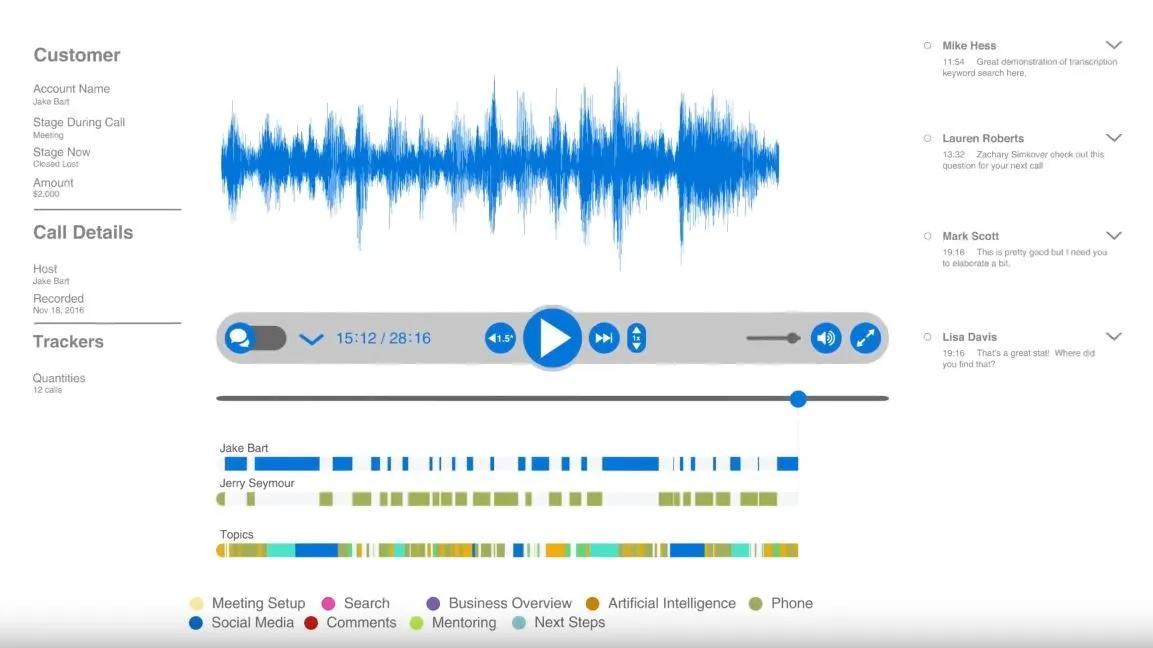 |
Revenue intelligence system Gong is definitely a tool to consider. This tool helps both reps and their managers understand what’s happening on their calls. It dives into the details of topics discussed, talk time, objections, and how different aspects of the call or pitch affect the final outcome of the deal.
Best feature for sales tracking: Sales call tracker that adds deeper insights to your tracking data.
3. Klipfolio
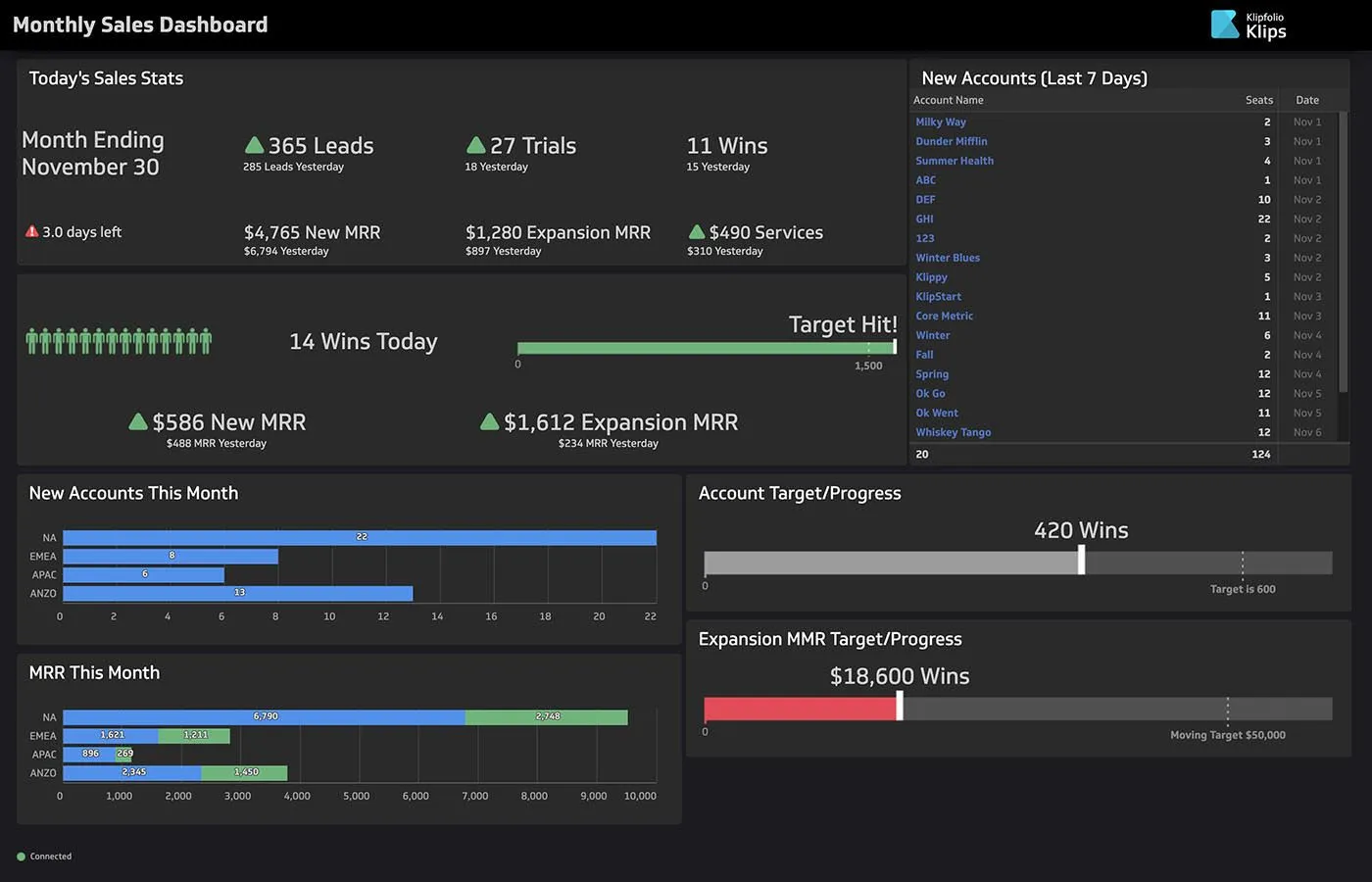 |
To collect your data into one single source of truth, as discussed above, you’ll probably need a customizable dashboard tool that connects with the tools where you gather your data. If you’re considering dashboard tools, Klipfolio should be on your list. This tool is extremely customizable, allowing you to pick from different templates for sales dashboards or create your own dashboard completely customized to your favorite metrics and KPIs.
Best feature for sales tracking: Makes sales tracking easy by pulling data from all of your favorite tools and building visual dashboards that can be easily shared with your team.
4. Google Analytics
 |
As discussed above, tracking customer and lead behavior on your website is an important aspect of lead tracking. One of the most widely-used tools for web analytics is Google Analytics: With it, you’ll be able to track how people use your website, where certain users stop to dig deeper, and how they journey through your different pages as they go through your sales pipeline.
Best feature for sales tracking: Web analytics that help marketing and sales work together and track how sales are made online, and how customers and leads interact with your website.
5. Reply.io
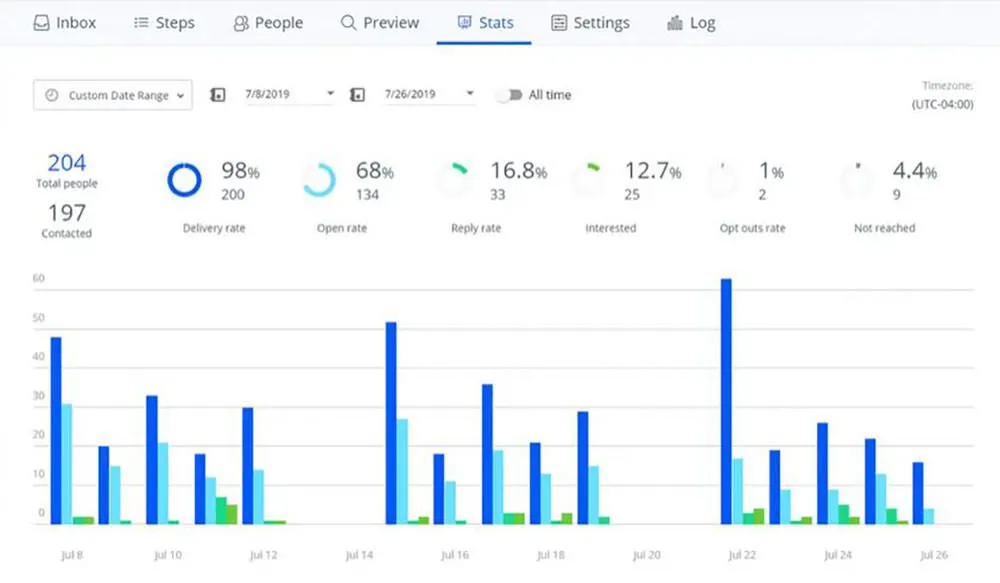 |
If you want deeper insights into how your emails are working for your sales team, you should consider a sales email tracking tool like Reply.io. This sales engagement platform lets you dig deep into data of all the emails your team sends. It also analyzes emails while you’re writing them and gives suggestions on improving the quality of what you’re sending.
Best feature for sales tracking: Deeper analytics into the open rates, response rates, and interest rates of the emails your team sends.
Build Your Own Sales Tracking Strategy + Close More Deals
You’ve just finished the ultimate guide to sales tracking. Put these tips into practice, and you’ll build a system for constantly improving your sales process.
Markets change. Competitors come and go. Your customers’ needs fluctuate.
Don’t let those changes take the rug out from under you.
By building your own sales tracking system using the methods and tools we discussed above, you can always keep an eye on your sales process and activities and optimize them for success in the current market.
Then, you’ll be ready to adapt to whatever the world throws at you.
Want to get a head start on sales tracking? Start your free trial of Close and see how this agile CRM can help you track sales activities, leads, pipelines, and more.











